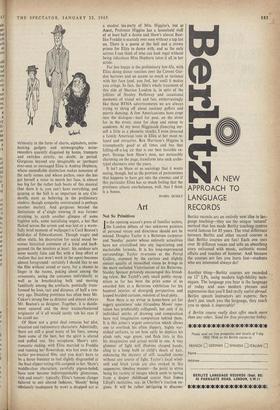Art
Not So Primitives I N the opening season's press of familiar names, 'the London debuts of two unknown painters of personal vision and directness should not be missed. Douglas Taylor is a Battersea carpenter and 'Sunday' painter whose unlovely actualities have not crystallised into any ingratiating and marketable formula. It is his long-experienced surroundings Taylor re-creates at the Portal Gallery, stamped by the curious and slightly sinister quality of intensified vision he brings to the more secluded Victorianism of his Battersea. Stanley Spencer privately encouraged this brood- ing talent. But Taylot's only small public recog- nition so far has been the prize some of us awarded him at a Battersea exhibition for his haunted interior of divergint perspectives and looped braided curtains, redolent of local piety.
Now there is no virtue in home-born art for sugary quaintness' sake (Grandma Moses' repu- tation has predictably collapsed), but only if its individual quirks of drawing and composition have real imaginative compulsion behind them. It is this joiner's urgent conviction which allows one to overlook his often slipper}, highly var- nished surfaces, to see how aptly be deploys his plush reds, sage green, and flesh tints in this his imaginative and actual world in one. A tiny glimmer of light will illumine clasped hands, cling to a lamp bulb or child's shock of hair, enhancing the mystery of still, tasselled rooms without any source of light. Taylor's local wind- mill and brick yards are also evoked in this suspensive, timeless manner—the point to stress being his variety of images which seem to spring from a deeper childhood source than James Lloyd's rusticities, say, or Chesher's traction en- gines. It will be rather intriguing to discover what Vienna and Los Angeles make of Douglas Taylor, when the Portal Gallery's obsessive, self- taught artists are shown abroad together in the spring.
Conrad Romyn is a professional painter, very conscious (as Taylor is perhaps hardly conscious himself) of his happiest effects, yet as true to a contemplative vision which transcends fashion.
In a period of classified pigeon-holes, Romyn is the kind of impassioned misfit who might have found sanctuary at the Beaux Arts. In fact, how- ever, the Upper Grosvenor Galleries mount this travelled artist's first London show of peasants or shepherds ruminating about rocky shores, un- wieldy fishermen closing in their nets, all with a sense of immemorial ritual. The elements in this imaginative world are transformed from sharpest visual impressions of Brittany or wherever. Only to indicate its character one might recall perhaps the ungainly folk of Permeke en- circled by the phosphorescent ambience of Kokoschka's Cornish cove.
Here Romyn aims at a mural effect of strung- out figures, heightened by his poetic feeling.
Other points of departure are suggested by wry characterisations, and a luminous checkered table- piece as sensuous as a Bonnard. The broadly vigorous and varied handling, and colour sup- porting the feeling of elemental forces, make Conrad Romyn a name to remember. If he could but identify himself passionately with the myth of a particular tract we might have an artist to approach the epic quality of Jack Yeats.
Finally, the Arts Council's present show of the late Arshile Gorky's drawings at the ICA Gallery is a dizzy forerunner of his retrospective, opening at the Tate on April 2. Then we may consider this ill-fated interior visionary as a catalyst of American-type painting twenty years ago.
NEVILE WALLIS







































 Previous page
Previous page